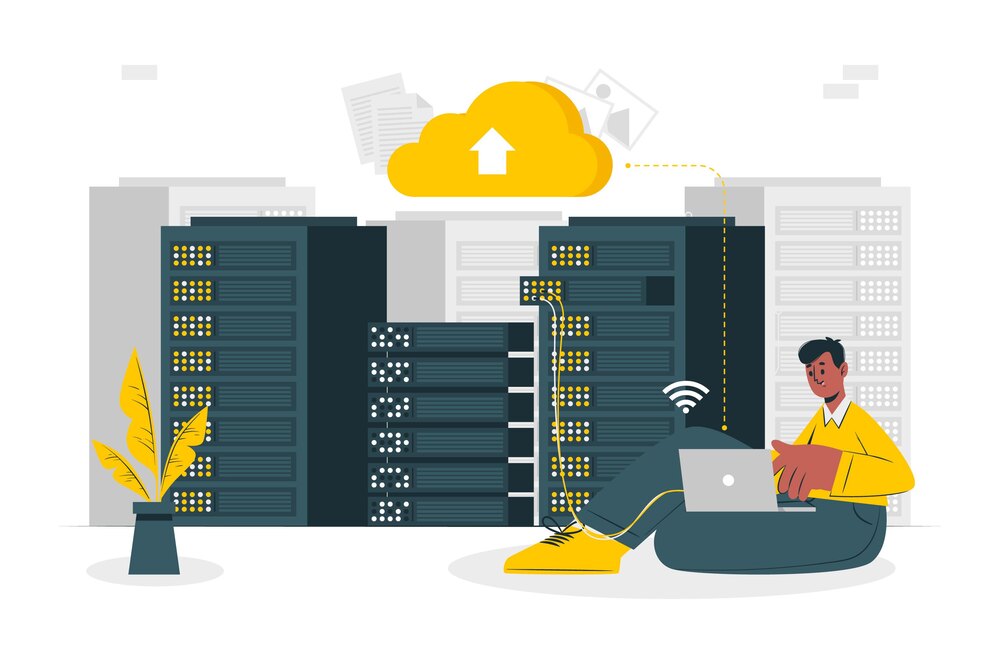
Cloud computing has become essential for businesses looking to streamline operations, reduce costs, and scale efficiently. As businesses grow, so does the complexity of their infrastructure needs. Efficient cloud computing architecture ensures that businesses can handle these complexities while optimizing resource usage.
In this article, we will explore the principles, challenges, and advanced strategies for building efficient systems with cloud computing architecture.
What is Cloud Computing Architecture?
Cloud computing architecture refers to the structure of IT systems and services provided over the cloud. It’s the blueprint for how cloud-based solutions are designed, deployed, and managed. At its core, cloud computing architecture consists of several components working together, including computing, storage, networking, and security.
Key Components of Cloud Architecture
Cloud architecture generally consists of three key components:
- Compute: This includes the servers and virtual machines (VMs) responsible for processing and running applications and services.
- Storage: Cloud storage solutions allow businesses to store data remotely, with options ranging from file storage to object storage and database management systems.
- Networking: Networking components in cloud architecture ensure communication between cloud services and external devices, enabling smooth data transfer and integration.
Additionally, businesses must choose from various cloud deployment models: public, private, and hybrid clouds. Each offers distinct advantages depending on the company’s specific needs, such as flexibility, security, or cost efficiency.
Key Principles of Efficient Cloud Computing Architecture
Efficient cloud architecture goes beyond simply setting up cloud systems; it involves optimizing resources, reducing overhead, and ensuring scalability to meet business demands. Let’s delve into the core principles of building an efficient cloud infrastructure.
Scalability and Flexibility
One of the primary advantages of cloud computing is scalability. Cloud systems allow businesses to scale resources up or down based on demand. This elasticity is crucial, particularly for companies with fluctuating workloads. Instead of over-provisioning resources, which can lead to unnecessary costs, cloud architectures automatically adjust to optimize performance and cost.
Resource Optimization: Maximizing Efficiency
Optimizing cloud resources involves ensuring that every component of the system is used effectively. Techniques like load balancing, automated resource allocation, and intelligent scaling ensure that resources are deployed based on demand, which reduces wastage and lowers operational costs. By optimizing resource utilization, businesses can achieve significant cost savings without sacrificing performance.
For example, a company can use auto-scaling to adjust the computing power needed based on the amount of traffic on their website. This method ensures that the system is never overburdened and costs are controlled.
In addition, cloud systems can implement load balancing, which evenly distributes traffic across servers, improving performance and uptime. HIVO discusses how effective resource allocation contributes to enhanced cloud efficiency.
Automation in Cloud Infrastructure
Automation is another key principle that contributes to cloud system efficiency. By automating routine tasks such as monitoring, patching, and resource management, businesses can reduce the need for manual intervention, minimize human error, and improve operational efficiency. Automated systems also ensure consistent performance and scalability, even under high traffic or workload demands.
Automation tools in cloud systems typically include Infrastructure as Code (IaC), which enables the automation of infrastructure setup and management using code, as well as continuous integration/continuous deployment (CI/CD) pipelines that automate the deployment of new software and updates.
Designing Cloud Systems for Business Efficiency
When designing a cloud system for a business, it’s essential to consider the specific needs and objectives of the organization. By aligning cloud architecture with business goals, companies can achieve enhanced performance, scalability, and cost efficiency.
Customizing Cloud Solutions for Specific Business Needs
Every business has unique requirements, which is why cloud solutions should be tailored to meet specific objectives. For example, a large enterprise may opt for a hybrid cloud model, combining the flexibility of public cloud services with the control of private cloud infrastructure. In contrast, a small startup might choose a public cloud for cost-effective scalability and minimal infrastructure management.
When selecting the right cloud model, businesses must assess factors such as data security, compliance, and budget. A well-designed cloud system aligns these factors to meet the business’s needs efficiently.
The Benefits of Cloud Migration for Efficiency
Migrating to the cloud can drastically improve business operations by increasing agility, scalability, and cost efficiency. As companies move their data and applications to the cloud, they free themselves from the constraints of on-premise infrastructure, which can often lead to higher capital and operational expenditures.
Cloud migration also allows businesses to take advantage of the latest innovations in cloud technology, such as AI and machine learning tools, which can enhance operational efficiency.
Google Cloud outlines the benefits of cloud migration, emphasizing how organizations can leverage cloud services to gain a competitive edge, improve scalability, and reduce IT overhead. These improvements can be pivotal for businesses looking to stay competitive in a rapidly evolving technological landscape.
Performance Monitoring and Resource Allocation
Efficient cloud architecture is also about continuous monitoring and resource management. Cloud systems offer a range of performance monitoring tools that allow businesses to track key metrics such as response times, CPU usage, memory consumption, and bandwidth. These tools help ensure that the system is performing at its best and can handle fluctuations in traffic or workload.
By integrating performance monitoring with resource allocation systems, businesses can ensure that resources are efficiently distributed, avoiding overloading certain servers while underutilizing others. Real-time monitoring helps cloud architects make data-driven decisions about where to allocate resources, ensuring optimal performance.
Addressing Efficiency Challenges in Cloud Systems
While cloud systems offer numerous advantages, they also come with their challenges. To build efficient cloud systems, it’s important to identify and address these challenges proactively.
Overcoming Common Challenges in Cloud Efficiency
Some common issues in cloud systems include bottlenecks, underutilized resources, and performance degradation. Bottlenecks can occur when certain parts of the system, such as storage or processing power, are overwhelmed with traffic or tasks, slowing down performance.
Cloud architects can address these challenges by regularly assessing system performance, implementing load balancing, and ensuring that resources are allocated according to demand. Additionally, techniques such as containerization can help break down large applications into smaller, more manageable pieces, making the system more flexible and efficient.
The Role of DevOps in Cloud Efficiency
DevOps is a crucial methodology for enhancing cloud system efficiency. By combining development and operations into a single, collaborative approach, DevOps ensures that cloud systems are continuously optimized for performance and scalability.
The implementation of DevOps automation tools enables teams to streamline processes, reduce human errors, and improve the overall system’s agility and responsiveness.
For businesses looking to integrate DevOps into their cloud architecture, tools like Jenkins, Docker, and Kubernetes can automate deployment, testing, and scaling. These tools enhance cloud system efficiency by enabling rapid development and seamless integration.
Advanced Strategies for Building Efficient Cloud Systems
To take cloud architecture efficiency to the next level, businesses must adopt advanced strategies that address scalability, resource management, and performance optimization.
Implementing Converged Architectures for Centralized Management
Converged cloud architectures integrate computing, storage, and networking into a single, streamlined platform. This centralized approach simplifies management, reduces complexity, and enhances resource utilization. With a converged architecture, businesses can manage their entire IT infrastructure more efficiently, ensuring that resources are allocated where they are needed most.
Using Business Intelligence Software in Cloud Systems
Cloud-based business intelligence software plays a significant role in optimizing decision-making processes by providing real-time data analytics and reporting. These tools integrate with cloud systems to deliver actionable insights that help businesses optimize performance, reduce costs, and improve customer satisfaction.
By utilizing cloud-based analytics platforms, businesses can gain a deeper understanding of their operations, enabling them to make more informed decisions that lead to greater efficiency.
The Future of Efficient Cloud Systems
The future of cloud computing will see continued advancements in automation, machine learning, and artificial intelligence, all contributing to more efficient cloud systems. Emerging technologies like edge computing are also set to revolutionize cloud efficiency by processing data closer to the source, reducing latency, and optimizing bandwidth usage.
The Growing Role of IT Management Services
As businesses increasingly rely on cloud computing, IT management services are becoming more essential in ensuring the smooth operation of cloud systems.
IT service management software helps businesses monitor, manage, and optimize cloud resources in real time, improving overall system efficiency and ensuring that all services are running optimally.
Conclusion
Building efficient systems with cloud computing architecture is essential for businesses aiming to stay competitive and cost-effective. By leveraging key principles such as scalability, resource optimization, and automation, companies can streamline their operations and enhance performance.
With the right strategies, cloud architecture can become a powerful tool for achieving business objectives and driving growth.
By embracing the power of cloud computing, organizations can unlock new opportunities, improve operational efficiency, and stay ahead of the curve in a rapidly changing technological landscape.
Ready to innovate and transform your business? Say hello to CodeBeavers!
If you are looking for ways to bring your product or app ideas to life? We’ve got your back. CodeBeavers has the tools and engineers you need to make your projects come alive. With CodeBeavers, you’ll be able to build faster than ever, deploy code with ease, and scale like never before. Send us your requirements now, and let’s start winning together.




